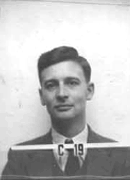Ernest William Titterton was a British nuclear physicist who worked on the Manhattan Project as part of the British Mission to Los Alamos.
Born in Kettlebrook, England, Titterton attended Birmingham University, where he received his B.Sc. in 1936, his M.Sc. in 1938, his teaching diploma in 1939, and his Ph.D. in 1941. For his master’s degree he worked with Mark Oliphant, studying the alpha particle activity of samarium. Titterton took up a teaching post at a secondary school, but after the war started he was asked by Oliphant to return to Birmingham University to join the war effort. There Titterton worked as an Admiralty Research Officer, developing radar systems for the British government. He developed new types of spark-gap modulators, which increased the resolution in radar pictures of airplanes. Even though it was top secret work, he was allowed to use it to receive his Ph.D. While there, Titterton met Peggy Eileen Johnson, a laboratory assistant. The two married in 1942.
Titterton was then assigned to be Otto Frisch’s research assistant in the new “Tube Alloys” program, the British effort to develop nuclear weapons. While performing experiments on cross sections for neutron-induced fission, the two observed spontaneous fission of uranium. They could not publish their findings, however, and so the credit for the discovery went to a team of Russian scientists. Titterton then traveled to Liverpool University to study the timescale of neutron emission after fission.
When Great Britain officially transferred control of the atomic bomb project to the United States, Titterton was chosen as part of a small number of British scientists to travel to American laboratories. As part of the British Mission to Los Alamos, Titterton was assigned to Robert Wilson’s cyclotron group. There he repeated the experiments he performed in Liverpool, searching for delays between fission and neutron emission. His findings helped prove the possibility of a nuclear chain reaction. Titterton then focused on studying the implosion-type detonation mechanism. He helped create a method to determine the timing of the implosion, which showed that the initial method did not lead to a symmetrical implosion. This alerted the scientists to the need of “lenses” to precisely collapse the core. Titterton developed a two-dimensional system that was expanded to three dimensions by the Ordnance Division. Titterton also worked with field tests of the implosion-type bomb, which ensured the bomb would detonate at the right height. On July 16, 1945, Titterton triggered the Trinity test and helped monitor its progress.
After the war Titterton was selected to advise the Naval Research Laboratories in Washington, D.C., on the Operation Crossroads nuclear tests. While the government barred everyone but U.S. nationals from working on nuclear weapons, Titterton was asked to stay due to his expertise in timing measurements. Titterton performed the countdown for both tests at Bikini Atoll. He was named head of the Electronics Group at Los Alamos, but returned to England in 1947.
In England, Titterton joined the newly formed Atomic Energy Research Establishment, located in Harwell. A member of the General Physics Division, he was tasked to build and lead a research group working with nuclear emulsions and cloud chambers. Titterton’s research at Harwell was prodigious; in just a few years he published twenty-eight papers on a variety of topics in nuclear physics.
In 1950, he was named the Foundation Chair of Nuclear Physics at the Australian National University by Oliphant. Titterton built the Department of Nuclear Physics from the ground up, and later served as first Dean of the Research School of Physical Sciences and then as its Director. During this time, Titterton also assisted with British atomic weapons tests in Australia. Titterton was an Australian observer for the early “Hurricane” and “Totem” tests, and then served as one of the founding members of the Atomics Weapons Tests Safety Committee for future British nuclear weapon tests. The committee was responsible for matters of public safety, but was the object of severe criticism by a later Royal Commission into the tests. Titterton ended his career as a professor in the Department of Nuclear Physics. He retired in 1981, but continued working as a visiting fellow.
Titterton was elected to the Australian Academy of Science in 1954, and was knighted in 1970. He died on February 8, 1990.





